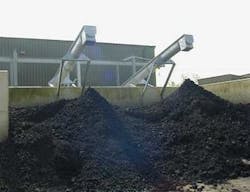Decanter centrifuges solve sludge backlog problem
Yorkshire Water clears a backlog of 50,000 m3 of sludge that resulted from the breakdown of belt presses by installing the Alfa Laval Aldec G2 decanter centrifuge.
Two Aldec G2 decanter centrifuges from Alfa Laval helped the UK company Yorkshire Water avoid a potential environmental problem at its Esholt sewage treatment works by clearing a backlog of 50,000 cubic metres (m3)of sludge in six months.
Part of the Kelda Group, Yorkshire Water provides 1.7 million households and 140,000 businesses in the North of England with water and sewerage services. The company supplies daily around 1.24 billion litres of drinking water - equivalent to a glass of water for every person on the planet - and also treats and safely returns about one billion litres of wastewater back into the environment everyday.
Covering no less than 340 acres, Yorkshire Water’s Esholt Sewage Treatment Works is the largest filter site of its kind in Europe. Its complex of mineral filters handles the sewage generated by a total equivalent population of 600,000 and produces a humus sludge that is treated, dewatered and then mixed with wood waste to produce a rich conditioned compost that is used for agriculture and land remediation.
Until last year, three traditional belt presses dewatered the sludge, producing a dry cake of 18 per cent Dry Solids (DS) on new humus and slightly less than that from old humus. Unfortunately, the belt presses never achieved the levels of throughput for which they were originally specified and, as a consequence, a backlog of humus continuously built up.
The problem became critical last year following a series of breakdowns that left Yorkshire Water with the problem of how to clear an accumulation of 50,000 m3 while still continuing to cope with an average daily output from the lagoons of around 1,400 m3. Yorkshire Water has an enviable reputation for environmental awareness and, in fact, at the beginning of 2005 picked up the title of Utility Company of the Year at a prestigious awards ceremony held by the UK magaazine “Utility Week” in London. Yorkshire Water officials were, naturally, anxious to clear the accumulated sludge as quickly and efficiently as possible.
“We were facing a potentially major environmental problem,” Ben Roche, Yorkshire Water’s catchment manager explained. “The Belt Presses simply couldn’t provide the level of performance we needed to keep pace with the output of the lagoons and the store of treated humus was reaching crisis proportions.”
Aldec G2 clears the backlog
Officials at Yorkshire Water decided to use this situation as an opportunity to consider various options given that they had already decided that the belt presses were unlikely to provide the answer either to the immediate problem of the accumulated humus or the predicted increase in demand. Alternative solutions included the use of decanters and other types of dewatering equipment. Alfa Laval provided a test rig consisting of a standard Aldec decanter centrifuge mounted in a trailer.
Tests were carried out at Esholt and two other Yorkshire Water sites to compare the rig-mounted decanter’s performance against the installed belt presses. After reviewing the test results and confirming that the decanter centrifuge had outperformed the belts by a considerable margin, Yorkshire Water installed two ALDEC G2 decanter centrifuges, which Alfa Laval had just recently introduced.
“We looked at a number of decanter options but the specification of the G2 looked tailor-made for our situation,” Ben Roche said.
More compact than its predecessors, Alfa Laval’s Aldec G2 incorporates a new gearbox that provides more power for less energy consumption because it maintains high torque levels over a wide range of differential speeds. These, in turn, are governed by the volume and composition of the solids in the sludge. With a drive system that allows both the bowl speed and the conveyor speed to be controlled independently of each other, the Aldec G2 also has the lowest power consumption, under all conditions, of any sludge decanter centrifuge currently available.
Once installed and commissioned, the pair of Aldec G2 decanters began clearing the 50,000 m3 of stored humus while still handling the daily output of the lagoons.
The machines run continuously, 24 hours per day, 365 days per year, each processing an average of 30 m3 of humus - containing 4 per cent DS - every hour and producing a cake with 25 per cent DS. They have proved equal to the task not simply in terms of clearing the backlog, but also in the improvement in cake dryness and quality which makes it easier to handle and store.
The compost produced by mixing the dewatered sludge with wood waste is stored in windrows at a rate of two tonnes per square metre and then left to mature. Once conditioned, the sludge is spread up to a foot deep across prepared areas on the site and then seeded with grass. This removes more bacteria and also thickens the product prior to its final use, after harvest, as a valuable agricultural fertiliser.
Author’s Note
Peter Rose is the marketing manager of Alfa Laval, located in Camberley, Surrey, UK.


